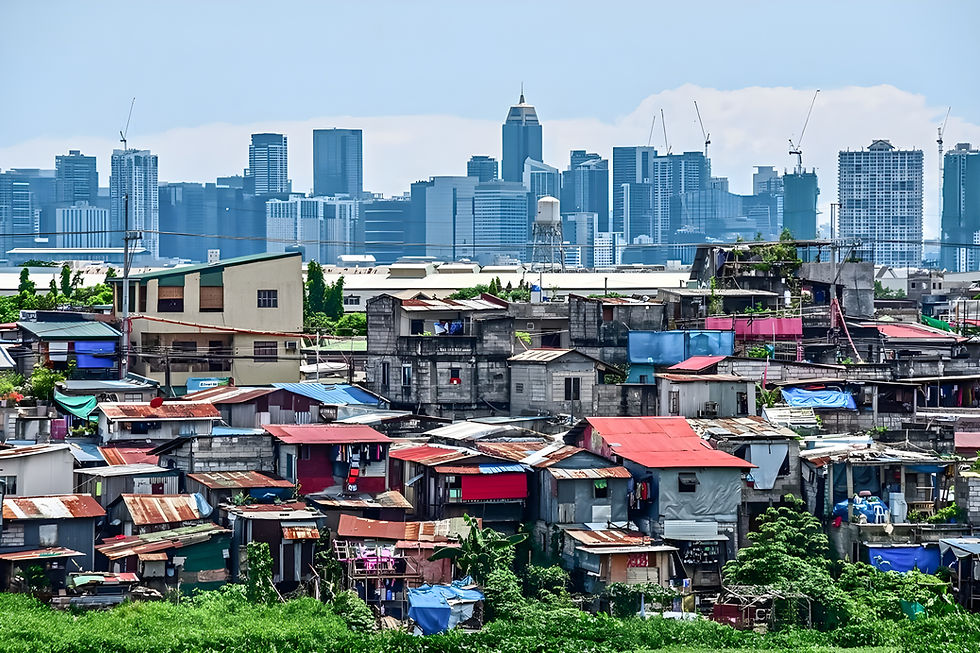Manila’s Outsized Role in the Philippines’ Fragmented Economy
Aug 30, 2025

EXECUTIVE SUMMARY
Metro Manila and nearby provinces account for nearly 50% of the Philippines’ GDP with only a quarter of the population, a level of urban primacy matched globally only by Phnom Penh, Bangkok, and Buenos Aires, and far exceeding Jakarta, Ho Chi Minh City, Johannesburg, or Lagos. Colonial legacies, constitutional restrictions, and elite dominance entrenched Manila as the country’s hub, while weak governance, poor infrastructure, and risk-averse conglomerates keep secondary cities from scaling. With 70% of BPO jobs and the largest consumer base, Manila continues to capture most investment, making the Philippines one of the world’s clearest cases of primate city dominance.

Author:
John P. Causey IV
Manila’s Outsized Role in the Philippines’ Fragmented Economy
Metro Manila (also known as the National Capital Region, or NCR) and its surrounding provinces account for close to half of the Philippines’ GDP, a rare concentration by global standards. The NCR itself produces about 32 to 36 percent of national output despite being home to only around 12 percent of the population. Once the surrounding provinces of Cavite, Laguna, Rizal, and Bulacan are included, the GDP share rises to nearly 50 percent, containing about 25 to 30 percent of the population.

This level of urban primacy is unusual, seen mostly in smaller or less diversified economies where one city dominates political and economic life. Manila’s GDP share places the Philippines in a narrow peer group that includes Phnom Penh, Bangkok, Montevideo, and Buenos Aires, all producing close to half the national output. By contrast, Lagos contributes about 25 to 30 percent of Nigeria’s economy, Jakarta around 20 to 25 percent of Indonesia’s, Ho Chi Minh City just over 20 percent of Vietnam’s, and Johannesburg roughly 15 percent of South Africa’s. In advanced economies, no single city typically produces more than 20 to 25 percent of output.
Only Argentina, Thailand, and the Philippines are mid-to-large economies ($400–600 billion) where the capital region produces roughly half of national GDP. Buenos Aires generates about 50 percent of Argentina’s $640 billion economy with a population of 46 million, Bangkok accounts for a similar share of Thailand’s $540 billion output with 72 million people, while Metro Manila and its surrounding provinces contribute close to 50 percent of the Philippines’ $440 billion economy despite a much larger population of 118 million. This makes the Philippines unusual in combining extreme concentration with significantly greater populations than its peers.
Colonial Foundations of Supremacy
The roots of Manila’s dominance can be partially explained by its colonial history. First the Spanish (1565–1898) and later the Americans (1898–1946) concentrated administration, ports, and commerce in the capital, establishing Manila as the central node for governance and trade. Colonial powers generally aim for extraction rather than integration, favoring a single “gateway city” to base governors, traders, missionaries, and soldiers.
Manila was chosen for strategic reasons. Manila Bay offered one of Asia’s finest natural harbors, deep and easily fortified, while the Pasig River linked it to fertile inland plains. Its location on western Luzon provided a direct maritime route to Mexico, anchoring the Manila Galleon trade that for 250 years exchanged American silver for Chinese silk and porcelain, tying the Philippines into one of the earliest global trading systems. Cebu and Iloilo had regional importance but lacked Manila’s harbor quality, defensive advantages, and trans-Pacific access. The Americans inherited this system and reinforced it, modernizing infrastructure but leaving Manila as the country’s undisputed center rather than creating new economic hubs.
Manila’s Persisting Structural Advantage
By the 20th century, Manila’s dominance was entrenched in both infrastructure and politics. Railways and highways radiated outward from the capital rather than connecting provinces directly, ensuring commerce passed through Manila. Today more than 65 percent of port traffic flows through Manila, and Ninoy Aquino International Airport remains the country’s main international gateway.
The 1987 Constitution further reinforced centralization by restricting foreign ownership in land, utilities, and natural resources, entrenching a small group of families that dominate banking, real estate, telecommunications, and infrastructure. Groups like Ayala, SM, San Miguel, and Lopez are all based in Metro Manila and account for a significant share of the Philippine Stock Exchange’s market capitalization. Their proximity to government has fostered regulatory capture, where approvals and incentives disproportionately benefit Manila-based enterprises. Even the ₱8.3 trillion (about $160 billion) Build, Build, Build program between 2017 and 2022 under Duterte saw nearly half of flagship projects concentrated in Luzon, despite Visayas and Mindanao holding 40 percent of the population.
Secondary Cities Left Behind
Efforts to decentralize have had limited effect. The Local Government Code of 1991 devolved some fiscal authority, but most provinces still rely heavily on national transfers and lack strong local revenue bases. Land titling disputes, weak governance, and corruption reduce their ability to attract private investment, while customs, taxation, and central banking remain controlled in Manila. Infrastructure gaps compound the challenge. Inter-island logistics are costly, provincial ports and airports are congested or underdeveloped, and freight corridors are thin. Zones like Clark, Subic, and Cebu IT Park have proven alternatives are possible, but they succeed largely through special incentives rather than organic competitiveness. Tourism has helped diversify Cebu, Palawan, Boracay, and Bohol, but arrivals remain modest at 5.9 million in 2024, far below Thailand’s 35.5 million.
Business culture reinforces these barriers. Manila’s conglomerates see little reason to expand aggressively beyond Luzon, as political contacts, credit, and regulatory approvals are concentrated in the capital. Provinces present higher risks and fewer guarantees. The Philippines has reinforced Manila’s primacy through both political design and business culture, leaving secondary cities at a structural disadvantage. This pattern is mirrored in Brazil, where Sao Paulo groups dominate finance and industry but treat the northeast and interior as separate markets.
Other Southeast Asian countries have shown that policy and culture can push economic activity beyond the capital. In Thailand, deliberate state investment in transport and industrial estates has drawn Bangkok-based groups into regional tourism and manufacturing hubs, helping the country attract over 35 million tourists annually and build strong export zones in the east. Indonesia has fostered a dual core between Jakarta and Surabaya, while Vietnam’s growth is balanced between Ho Chi Minh City and Hanoi, each contributing roughly 20–25% of national GDP. These examples highlight how targeted policies, infrastructure, and broader political buy-in can prevent the kind of overconcentration seen in the Philippines.
Entrenched Dominance
Manila’s advantage is reinforced by sheer market size. Greater Manila’s 26 million residents represent the largest consumer base in the country, drawing retail, services, and real estate into the capital. Top universities and hospitals are concentrated there, pulling talent from across the archipelago and driving a steady brain drain from the provinces.
The outsourcing industry, a major foreign exchange earner, has spread to Cebu, Bacolod, and Davao, yet nearly 70 percent of BPO seats remain in Metro Manila. This concentration makes it difficult for secondary cities to scale, creating a cycle where labor, capital, and investment continue to flow back into the capital.
Without deliberate reforms and the creation of viable new economic corridors, the Philippines will remain one of the world’s starkest examples of primate city dominance, where growth runs through one metropolis while the rest of the country struggles to keep pace. A rewritten constitution could address many of these structural barriers, but entrenched political interests make this path uncertain. Until then, Manila will remain the country’s only truly scalable market for investors.
VANTAGE'S TAKE
The Philippines is somewhat unusual in how much of its economy is concentrated in a single metro. For investors, this means most scalable opportunities will remain in Metro Manila, where capital, talent, and consumers converge most strongly, but also where competition is fiercest. Foreign firms and investors will find themselves up against entrenched families protected and backed by a constitution that severely restricts participation by foreign firms, making uneven partnerships unavoidable.
The BPO industry is the notable exception. It has thrived precisely because it sits outside the 1987 constitutional framework, operating instead under legislative carve-outs that insulate it from ownership caps and the usual onerous regulatory impediments. The result has been the growth of a $35 billion sector employing more than 1.5 million Filipinos, clear evidence of what is possible when policy allows foreign firms to operate freely and fairly.









